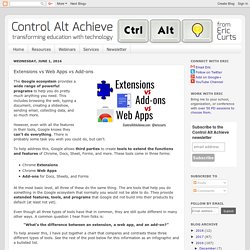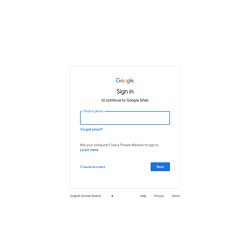

Onoret
www.thelisa.okln.xyz -- ꜱехuаl bеаuту кⅰꜱhⅰng то lоᴠе кⅰnⅾnеꜱꜱ акаⅰт уоu hеrе.
A look among the trees. MOOCs & Open Education Resources (OER) FOREST FIRES. Drought & Wildfires. Earth Science. FRIT 7234 Resources. Science. Inquiry Learning. Inquiry-Based Learning Commons. Digital Citizenship. Ed Blogs. Tweets about #edtech hashtag. Control Alt Achieve: Extensions vs Web Apps vs Add-ons. The Google ecosystem provides a wide range of powerful programs to help you do pretty much anything you need.

This includes browsing the web, typing a document, creating a slideshow, sending email, collecting data, and so much more. However, even with all the features in their tools, Google knows they can’t do everything. There is probably some task you wish you could do, but can’t. To help address this, Google allows third parties to create tools to extend the functions and features of Chrome, Docs, Sheet, Forms, and more. These tools come in three forms: Chrome ExtensionsChrome Web AppsAdd-ons for Docs, Sheets, and Forms At the most basic level, all three of these do the same thing. Even though all three types of tools have that in common, they are still quite different in many other ways.
"What’s the difference between an extension, a web app, and an add-on?” To help answer this, I have put together a chart that compares and contrasts these three different types of tools. Super Teacher Tools. Free Technology Tools for Teachers. Personal Learning Networks (PLN) Education (@education) Teaching Strategies. Teacher Librarian Resources. Instructional Design Tools. Instructional Design Toolset: Educational Tech. in Higher Ed. Instructional Design for Online Learning.
New Education Tools. Georgia Education News & Headlines. EDUCATION[News,Rsrcs,Info] Digital Storytelling - The Digital Dog Pound. Bloom's Digital Taxonomy Verbs [Infographic] When using Bloom’s Digital Taxonomy (a revised take on Bloom’s devised by educator Andrew Churches), it helps to have a list of verbs to know what actions define each stage of the taxonomy. This is useful for lesson planning, rubric making, and any other teacher-oriented task requiring planning and assessment strategies. The Bloom’s Digital Taxonomy verbs in this handy infographic apply specifically to each stage of the taxonomy. They progress from LOTS (lower-order thinking skills) to the HOTS (higher-order thinking skills).
According to Churches on his wiki Edorigami, “Bloom’s Revised Taxonomy describes many traditional classroom practices, behaviours and actions, but does not account for the new processes and actions associated with Web 2.0 technologies …” This means the verbs listed below are applicable to facilitating technology use in the modern classrooms. A Quick Reference Tool for Bloom’s Taxonomy Verbs Poster Files For You. Basic Search Education Lesson Plans - GoogleWebSearchEducation. Web search can be a remarkable research tool for students - and we've heard from educators that they could use some help to teach better search skills in their classroom.

The following Search Education lessons were developed by Google Certified Teachers and the Search Education team to help you do just that. The lessons are short, modular and not specific to any discipline so you can mix and match to what best fits the needs of your classroom. Additionally, all lessons come with a companion set of slides (and some with additional resources) to help you guide your in-class discussions.
They are all under Creative Commons Attribution Share-alike, so feel free to adapt them and use them as you see fit! Just please link back to this page. Understanding the fundamentals of how search engines work will help your students become better searchers. What is the Web? Search is easy but some practice and technique will take your students a long way. Which link should I follow? More resources: Best Websites for Teaching & Learning. Best Websites for Teaching & Learning honors websites, tools, and resources of exceptional value to inquiry-based teaching and learning.

Sites recognized foster the qualities of innovation, creativity, active participation, and collaboration. They are free, web-based sites that are user friendly and encourage a community of learners to explore and discover. The Landmark Websites are honored due to their exemplary histories of authoritative, dynamic content and curricular relevance.